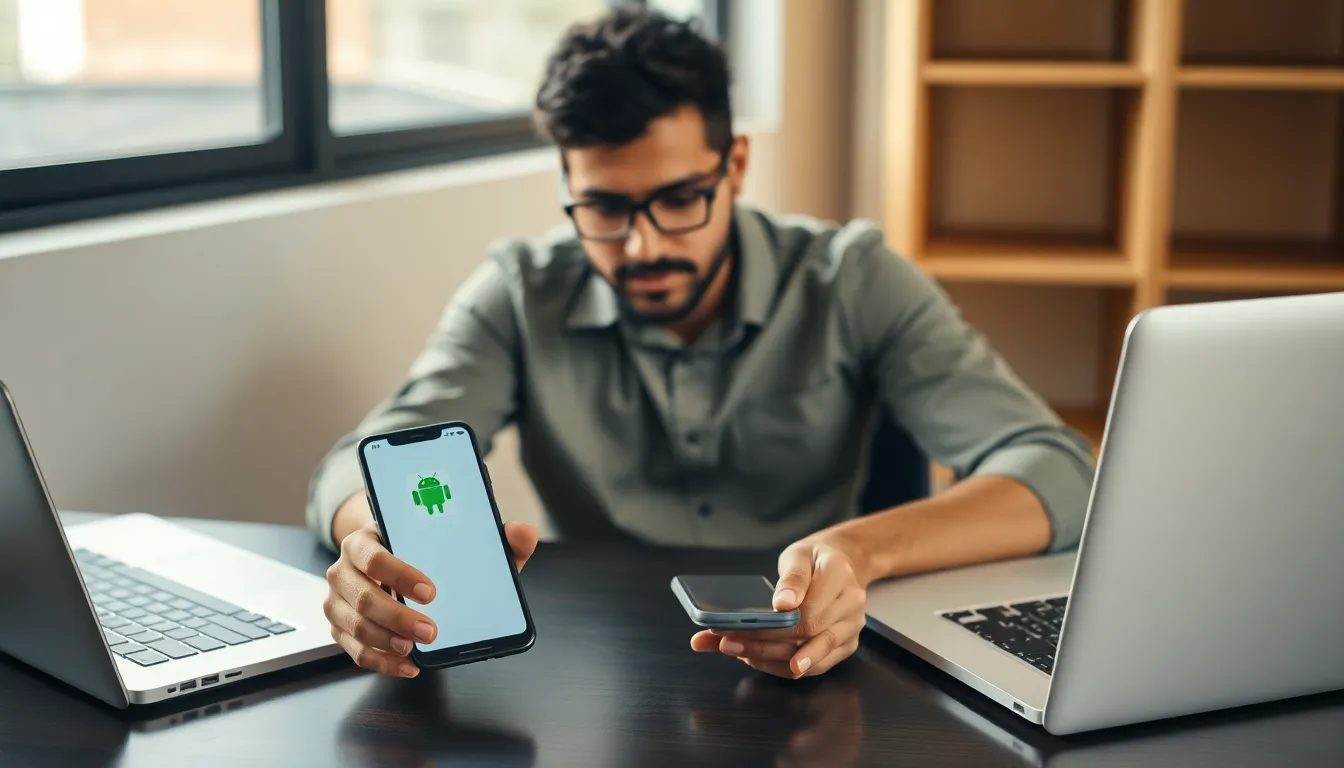Switching from Android to iPhone? It can feel like moving to a new country where you don’t speak the language. But fear not! Transferring your precious data doesn’t have to be a Herculean task. With the right tools and a sprinkle of patience, you can make the leap without losing your mind—or your memes.
Table of Contents
ToggleUnderstanding the Need for Data Transfer
Switching from Android to iPhone often brings various challenges. Users frequently face the daunting task of transferring contacts, messages, photos, and apps. Ensuring a seamless transition is vital for maintaining continuity in daily communication and important memories.
Data transfer serves significant purposes. It helps users retain valuable information, such as family photos, important contacts, and essential files. Reliability in accessing these items reduces feelings of loss and frustration during the switch.
Saving time can enhance the experience. Effective methods speed up the process, allowing users to enjoy their new device sooner. Several tools and applications simplify migration, ensuring important data transfers without unnecessary complications.
Security also plays a role in data transfer. Users often worry about data privacy and integrity during the migration process. Using secure applications and methods ensures protection against data mishaps and unauthorized access.
Considering these aspects, it’s clear that performing an effective data transfer is essential. Successful migration ensures users can fully embrace their new iPhone while carrying over crucial information. Adopting the right strategies and tools mitigates potential challenges, leading to a more enjoyable transition.
Overview of Data Transfer Methods

Transferring data from an Android to an iPhone involves several effective methods. Each method caters to different user preferences and needs.
Manual Transfer
Manual transfer requires connecting both devices to a computer. Users can then copy files such as photos, music, and documents directly. It allows for selective transfer, giving control over what data moves to the iPhone. By using USB cables, files transfer quickly and securely. However, contacts and messages require additional steps, often involving exporting from the Android device and importing to the iPhone.
Use of Third-Party Apps
Third-party apps streamline the data transfer process. Apps like “Move to iOS” facilitate the migration of contacts, message history, photos, and more. These applications guide users through each step, ensuring the transition is straightforward. They often require both devices to be on the same Wi-Fi network. Utilizing these apps can save time, making data transfer efficient and user-friendly.
Cloud Services
Cloud services act as intermediaries for data transfer. Services such as Google Drive or Dropbox enable users to upload files from the Android device and access them on the iPhone. Users enjoy the flexibility of transferring large amounts of data effortlessly. However, a stable internet connection is essential, and large file sizes might result in longer upload times. Syncing across cloud services can simplify keeping data up-to-date on both devices.
Step-by-Step Guide to Transferring Data
Transferring data from Android to iPhone can seem daunting, but following a clear process makes it manageable.
Using Move to iOS App
The Move to iOS app simplifies data migration. Install the app on the Android device from Google Play. When setting up the new iPhone, select the “Move Data from Android” option. An authentication code appears on the iPhone, allowing a secure connection. Once connected, select data types to transfer, including contacts, messages, photos, and mail accounts. The app guides users through every step, ensuring a comprehensive transfer. Users appreciate its ease of use and effectiveness in transferring essential data.
Transferring via Cloud Storage
Cloud storage solutions facilitate data transfer between devices. Users can upload files from an Android device to services such as Google Drive or Dropbox. After uploading, accessing those files on the new iPhone requires downloading the respective app. Important files, such as photos and documents, become readily available once logged into the cloud service on the iPhone. Setting up cloud storage accounts requires a stable internet connection, so users should ensure connectivity. This method provides a secure and flexible option for moving large amounts of data.
Manual Backup and Restore
Manual backup and restore offer another viable option for data transfer. Users can back up their Android devices to a computer using software like Samsung Smart Switch or Android File Transfer. This step involves connecting the Android device via USB and selecting data to backup on the computer. After backing up, the new iPhone requires a different process, utilizing iTunes or Finder for data restoration. This method allows users to selectively transfer important files, but it necessitates additional steps for contacts and messages, which may require exporting and importing separately.
Common Challenges and Solutions
Switching from Android to iPhone presents several challenges. Data compatibility issues often arise, as some files may not transfer seamlessly. Handling these discrepancies involves checking file formats before initiating the transfer.
Connectivity problems can also hinder data migration. Ensuring both devices have stable Wi-Fi access significantly streamlines the process. Users benefit from having their devices close together, minimizing disruptions during transfer.
Privacy concerns persist during migration. Utilizing trusted applications, like Move to iOS, enhances security and protects sensitive information. Users should avoid third-party apps lacking reviews or recommendations to ensure data integrity.
For those relying on cloud services, slow internet speeds can impede access to files. Using wired connections or transferring data during off-peak hours improves the uploading and downloading experience. Users obtain better connectivity and a faster migration process.
Limited storage space on the iPhone may lead to data loss. Checking available storage on the new device before initiating transfers avoids complications. Users can delete unnecessary files or back up data to an external source if needed.
Finally, not all apps available on Android have direct counterparts on iPhone. Researching app availability ahead of time helps users prepare for any necessary replacements. This proactive approach prevents users from facing unexpected gaps in functionality after the switch.
Recognizing these challenges and applying these solutions contributes to a smoother transition from Android to iPhone. Prioritizing data transfer methods and tools tailored to needs further enhances the user experience.
Switching from Android to iPhone doesn’t have to be daunting. With the right tools and methods at hand users can seamlessly transfer their data while ensuring important memories and contacts remain intact. Utilizing options like the Move to iOS app or cloud services simplifies the process and enhances security.
By addressing common challenges and preparing adequately users can enjoy a smooth transition. It’s crucial to check compatibility and storage to avoid potential hiccups. Embracing the new iPhone with all essential data in place allows for a more enjoyable experience, making the switch not just manageable but also rewarding.



